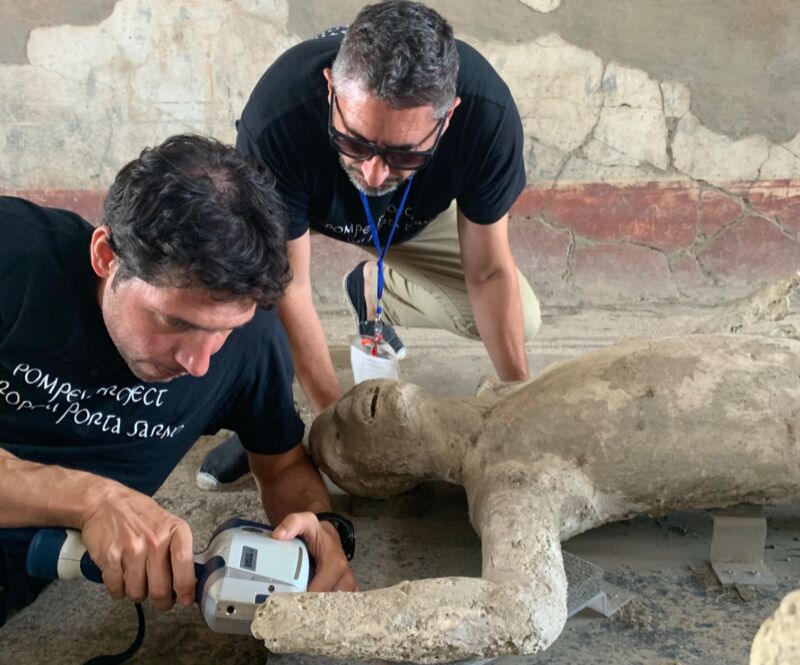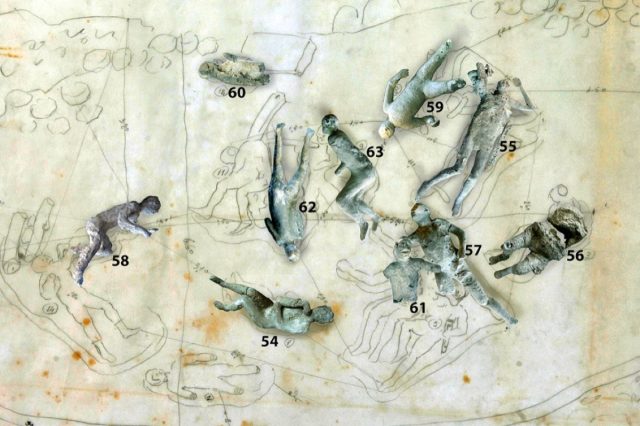
In the 1870s, archaeologists made plaster casts of those who died when Mount Vesuvius erupted in 79 CE, pouring the plaster into the voids left by decomposed bodies. The casts can still be viewed today and have proven especially useful to scientists keen to learn more about the actual cause of death of these victims. Was it asphyxiation, choking on the thick clouds of ash? Body evaporation from the extreme heat? A slower form of dehydration? Or some combination of all three?
A new paper published in the journal PLoS ONE describes a multidisciplinary analysis of seven plaster casts from Pompeii and concludes that these victims, at least, likely survived the early eruption and died some 20 hours later from asphyxiation, although the authors are careful to emphasize that their findings are only applicable to these particular cases. "It is likely that the catastrophic eruption killed people in different ways," the authors wrote, concluding that "generalizing and supporting a sole hypothesis of death becomes overly reductive."
As previously reported, the eruption of Mount Vesuvius released thermal energy roughly equivalent to 100,000 times the atomic bombs dropped on Hiroshima and Nagasaki at the end of World War II, spewing molten rock, pumice, and hot ash over the cities of Pompeii and Herculaneum in particular. Like the seven victims of this latest study, archaeologists believe that the vast majority of the victims died of asphyxiation, choking to death on the thick clouds of noxious gas and ash.
However, a 2001 study in Nature, co-authored by University of Naples archaeologist Pierpaolo Petrone, estimated a temperature of 500° Celsius (932° Fahrenheit) for the pyroclastic surge that destroyed Pompeii, sufficient to kill inhabitants in fractions of a second. In 2018, we reported on Petrone's conclusion that inhabitants of Herculaneum may have suffered a similar fate. He observed fracturing in the bones of some 100 excavated skeletons, as well as "cracking and explosion" of the skullcaps, consistent with forensic cases where skulls burst from extreme heat.

Petrone's 2020 follow-up study offered additional evidence that extreme heat killed many victims, based on analysis of one victim's skull in particular, first excavated in the 1960s from Herculaneum. There was evidence of brain matter remains in the skull. Usually such brain matter would be "saponified" by the extreme heat—that is, it turned to soap (glycerol and fatty acids). But this victim's brain matter had been vitrified, i.e., fused into glass. Later that year, Petrone reported fresh evidence that this might, indeed, have been the case, announcing his discovery of preserved human neurons in the victim with the "glassified" brain, although other scientists expressed skepticism about that finding.
The upshot is that we just don't yet fully understand all of the effects such an eruption would have had on the human body. Petrone's work focused on remains found at the Herculaneum site, most notably a boathouse near the shore. A 2020 study on bone remains supporting dehydration as a cause of death (as indicated by muscle contraction and body position, as well as preserved collagen in the skeletal remains) likewise focused on Herculaneum victims. So, archaeologists Gianni Gallello and Llorenç Alapont of the University of Valencia in Spain—both co-authors of the latest study—decided to focus their efforts on six casts from the Porta Nola area of Pompeii Archaeological Park and one from the city's suburban baths (Terme Suburbane).
Alapont et al. conducted the first non-invasive chemical analysis of those plaster casts using portable X-ray fluorescence (pXRF) in order to determine the elemental composition of both the bones and plaster. This data was then cross-referenced with anthropological and stratigraphic findings to reconstruct the perimortem and postmortem history of those victims. For comparative purposes, the team also took pXRF measurements of 44 bone fragments cremated prior to the Vesuvius eruption excavated from the same area, as well as 11 buried bone fragments from a Spanish Islamic necropolis.
reader comments
43